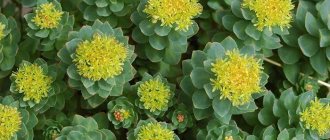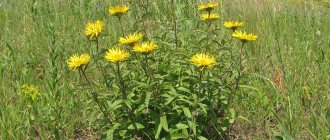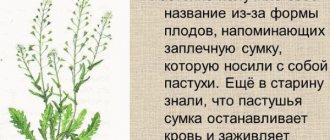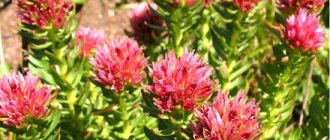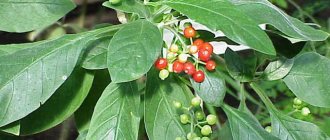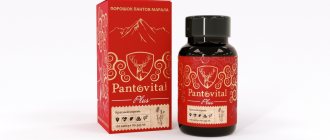The historical age of this amazing plant is estimated at more than three thousand years. The ancient healers of India and China mentioned it in their recipes. Medieval healers used calamus to treat typhoid, cholera, and colds. It was applied to wounds to prevent decay.
Calamus root was used as a spice, and its essential oil was added to various fragrant and antiseptic mixtures. Scientists cannot even now say where exactly the plant’s homeland was, but it is absolutely certain that Hippocrates successfully used it in his medicinal compositions.
Air photo
How to harvest calamus roots
After which they should be washed off the ground, all excess removed from the roots and cut into pieces of 20-30 cm.
The roots are first air-dried, then the roots are dried in a well-ventilated area.
When artificially drying, the temperature should not exceed 25-30 degrees; if this rule is neglected, the roots will become unusable, because at elevated temperatures the essential oil evaporates .
Medicinal properties
- improved digestion
- stimulates appetite
Spreading
The growing area of the plant is quite defined, although extensive. Iced root is common in the countries of Southeast Asia and Europe, as well as in North and South America. On the territory of the Russian Federation it is often found in the European part, southern Siberia and the Far East. Favorite habitats of calamus are river banks, lakes, ponds, streams and swamps; thickets of grass can be found in abandoned meadows and ditches.
It is believed that marsh cinquefoil came to Russia in the 13th-15th centuries; in the 15th century, the plant was recognized in Western Europe, but it reached the coast of North America only in 1783, and since then it has been actively grown.
The seeds of the plant in Asia are carried by insects and animals, but in Europe the grass reproduces using rhizomes. In the spring, during the period of ice melting and flooding, pieces that break off from the main root are carried by the current and take root in new places. The common calamus is considered a plant that promotes the development of ponds, since quiet, swampy creeks are especially suitable for its habitat, and you can not only get a plant harvest, but also clean the pond.
Calamus habitats - river banks, lakes, ponds
Medicinal properties of calamus
Calamus is a powerful nootropic herb that affects higher mental functions.
Nootropics stimulate mental activity, activate cognitive functions, improve memory and increase learning ability.
It has been known as a medicinal plant since ancient times, especially in China and India.
It is an important ingredient in most Ayurvedic medicines.
In the 16th century, German pharmacists sold several hundredweight of this root.
- Bitter essential oil and acorine increase appetite. It increases the secretion of gastric juice, improves digestion, and reduces stomach pain.
- Widely used in herbal medicine as an aromatic stimulant and mild tonic.
- Highly valued as a brain and nervous system rejuvenator and as a remedy for digestive disorders in Ayurveda.
- In small doses it reduces gastric acidity, while large doses increase gastric secretions, which is why it is recommended in the treatment of anorexia nervosa.
- Chewing the root relieves toothache.
- Activates the speech center of the brain. It is useful in treating speech disorders.
- Very effective for mental disorders.
- Used to treat schizophrenia, anxiety, depression and epilepsy. It also improves memory and learning processes.
- Used to treat throat conditions including sore throat, hoarseness, sore throat and related symptoms.
- It improves the pitch and quality of the voice.
- Used as an expectorant. Calamus liquefies phlegm and expels it from your body. Treats whooping cough, especially in children.
- Used in the treatment of various types of cancer such as lung cancer, breast cancer and liver cancer.
Used in the form of infusions, tinctures and powders.
- stomach diseases
- colitis
- hepatitis
- cholecystitis
- tonic for central nervous system depression
- kidney disease
- liver disease
- bladder diseases
- peptic ulcer of the stomach and duodenum
- bad breath
- inflammation of the mouth and gums
- inflammation of the larynx
- angina
- chronic tonsillitis
- stomatitis
- diarrhea
- rheumatism
- gout
- joint pain
- hypothyroidism
- arthritis
- swelling
- obesity
- asthma
- mouth ulcers
- syphilis
Digestive system
Calamus instantly relieves stomach problems. It cleanses the stomach and also relieves headaches caused by poor digestion. It relieves flatulence and colic, increases appetite. Used to treat anorexia, gastritis and stomach ulcers.
Anti-smoking
Chewing calamus root may cause you to dislike the taste of tobacco. Thus, those who are addicted to smoking can quit this habit by using this root. In addition, chewing or smoking tobacco often causes bad breath. Chewing the root can also help eliminate tobacco odor.
Oral diseases
Treats mouth ulcers and eliminates bad odor. Ayurveda uses the root as a pain reliever for toothache.
Treats insomnia
The aroma of calamus root is calming and can be used to treat insomnia. This calming effect can help relax your body and your mind.
Cough and fever
Along with a decoction of licorice root, it has a positive effect on cough, fever and colic in children. For a dry cough, chew calamus root for several minutes.
Skin diseases
Calamus root paste can be used externally for diseases such as eczema, ringworm and scabies. In the Siddha system it is used as a disinfectant for vaginal infections and foul-smelling discharges, mainly after childbirth.
Prevents infections
Calamus root is also capable of preventing infections, both internal and external. Due to its toxic substance, calamus root is used as a natural antibiotic.
For epilepsy
In the Siddha system, calamus is used with equal portions of asafoetida, haritaki, black salt, dry ginger, long pepper and black pepper to treat epilepsy and mental disorders.
Contraindications
The use of calamus is not recommended for the following categories of citizens:
- Those who have bleeding, regardless of their nature;
- Suffering from hypotension;
- Those who have increased acidity of gastric juice;
- For peptic ulcer disease in the acute phase;
- Women during pregnancy;
- Patients suffering from inflammatory diseases of the renal system in the acute phase;
- In the presence of individual allergic reactions.
Folk remedies from calamus root
- The rhizome powder is drunk with warm milk for sore throat.
- Preparations made from the rhizome are used to stimulate the flow of urine, relieve constipation and cleanse the body of impurities.
- Stewed rhizome is given for fever, cough and poisoning.
- A mixture of rhizome powder with dried ginger powder and honey is taken for partial paralysis of the mouth, chin and cheeks.
- A mixture of rhizomes and cashew oil is used to relieve swollen joints and sore muscles.
- For this, rubbing is used.
- A mixture of rhizome powder and honey is taken as a cure for epilepsy and to treat loss of sanity.
To stimulate appetite and for gastrointestinal diseases
1 tsp crushed roots, pour 2 cups of boiling water, boil for 15 minutes. Drink ½ glass 3 times a day before meals.
For the treatment of jaundice
1 tsp crushed roots, pour 1 cup of boiling water, leave for 20 minutes. Strain. Drink ½ glass 4 times a day.
For inflammation of the mouth and gums
1 tsp Pour 1.5 cups of boiling water over the crushed roots and leave for 2 hours. Strain. Rinse your mouth with warm infusion.
For bad breath
1 tbsp. Pour 1 cup of boiling water over the crushed roots and leave for 30 minutes. Strain. Rinse your mouth.
For inflammation of the larynx, sore throat, chronic tonsillitis, stomatitis
1 tbsp. Add crushed roots to 1 glass of cold water and leave for 5 hours. After this, boil for 20 minutes. Strain. Rinse your mouth.
For gastritis with low acidity
1 tbsp. Pour 1 cup of boiling water over the crushed roots and leave for 20 minutes. Strain. Take ½ glass 4 times a day 30 minutes before meals.
For diarrhea
Take ½ calamus roots and ½ oak bark. 1 tbsp. collection, pour 1 cup of boiling water. Leave in a thermos overnight. Strain. Drink ¼ glass 3-4 times a day before meals.
For rheumatism, gout, joint pain, arthritis
Grind the roots into powder. The daily dose of powder is 5 g. Take before meals.
Take baths for joint pain
2 tbsp. pour 1 cup of boiling water over the roots. Boil for 20 minutes. Leave for 30 minutes. Strain. Take the bath at night for 10-12 days. Water temperature 35-36 degrees.
For cholecystitis
1 tsp. Pour 1 cup of boiling water over the crushed roots and leave for 20 minutes. Strain. Drink 1/2 glass 4 times a day.
For diseases of the bladder, kidneys and urinary tract
1 tsp. pour 1 cup of boiling water over the roots and leave for 20 minutes. Strain. Drink 1/2 glass 4 times a day 30 minutes before meals.
For heartburn
Grind the roots into powder. Take 3-4 times a day, on the tip of a knife. Course 2-3 weeks.
For scrofula, rickets
1 tbsp. l. roots, pour ½ cup boiling water. Leave for 2 hours. Strain. Take according to
1 tbsp. spoon, 3 times a day, 30 minutes before meals.
For diathesis
Take baths. Pour 300 g of rhizome into 3 liters of water. Boil over low heat for 20–30 minutes. Strain and pour into the bath.
For eczema, allergic skin rashes
Take baths. 2 tbsp. l. roots, pour 1 liter of boiling water, boil for 20 minutes, leave for 30 minutes. Strain. The course of treatment is 10–12 baths. Water temperature 35-36 degrees.
For various wounds
Grind the calamus roots into powder and sprinkle it on the wounds.
For irregular menstruation
1 tsp. pour 1 cup of boiling water over the roots and leave for 20 minutes. Strain. Drink ½ glass 4 times a day 30 minutes before meals.
For hair loss
1 tbsp. l. pour 1 cup of boiling water over the roots and leave for 30 minutes. Rub into hair roots.
For dandruff
2 tbsp. spoons of roots pour 1 liter of water, boil for 15 minutes. Strain. Make masks from the decoction: rub the decoction into the roots and leave for 20 minutes. There is no need to rinse the decoction from your hair.
For oily hair
2 tbsp. spoons of roots pour 1/2 liter of boiling water, boil for 2-3 minutes over low heat, cool, strain. Add a tablespoon of vinegar or the juice of 1 lemon, 40 ml of calendula alcohol tincture. Rub into hair roots.
For split ends of hair
2 tbsp. spoons of roots, 2 tbsp. burdock roots pour 1.5 liters of water, boil for 20 minutes. Leave for 6 hours. Rub the decoction into the scalp.
For the flu
Chew the roots.
Compote of calamus and apples
You can make compote from both fresh and dried apples. Fresh apples 300 g (if dry, take 3 times less), pour 1 liter of water and cook until tender. Then add 2 tbsp. dry roots of calamus, if the roots are fresh, you will need 1 cup. Boil. After this, leave for 5-10 minutes. The compote is ready, you can sweeten it if desired. Preferably with honey, when the compote has already cooled down and its temperature does not exceed 40-50 degrees.
To secrete gastric juice (achylia)
Calamus rhizomes 1 part, cinnamon bark 1 part, trifoliate leaf 1 part, orange peel 2 parts, centaury herb 2 parts, wormwood herb 2 parts. 1 tsp collection, pour 1 cup of boiling water. Cool. Strain. Drink 1/4 cup 4 times a day, before meals.
Chemical composition
The rhizomes of marsh calamus are especially valuable for their essential oil content. Its concentration in high-quality raw materials reaches 5%. The essential extract has a pleasant, invigorating aroma and a refreshing spicy-bitter taste.
Composition of calamus essential oil:
- camphene, camphor;
- akoron, isoakoron;
- pinenes;
- borneol;
- eugenol;
- asaron.
Calamus exhibits most of its medicinal properties and contraindications precisely due to these terpene compounds in the oil.
In addition to the essential components, the following substances were found in the rhizomes:
- specific bitter glycoside acorin, acaric acid;
- glycoside luceninone;
- high content of vitamin C;
- significant iodine concentration;
- tannins;
- starch (about 20%);
- choline, resins, mucus.
The carrier of the specific smell of calamus is azarin aldehyde. The complex chemical composition of the rhizomes of the marsh plant determines its unique effect on the human body.
Tonic tea
- Calamus roots (1 part)
- Veronica officinalis (2 parts)
- St. John's wort (14 parts)
- Lovage, root (4 parts)
- Wild strawberry, leaves (2 parts)
- Juniper, fruits (1 part)
- Ruta fragrant (4 parts)
- Yarrow (2 parts)
- Chicory root (2 parts)
- Rose hips, fruits (4 parts)
2 tbsp. collection, pour 0.5 liters of boiling water. Leave overnight. Take 3 times a day, 30 minutes before meals, in equal parts.
Calamus root in Ayurveda
Headache. Make a paste from the roots. Apply this to the sore area.
Rheumatoid arthritis. Apply the root paste to the affected areas.
Cholera. Grind the roots. Boil 1 teaspoon in 1 liter of water. Strain. Drink 4 times a day.
Cough. Roast calamus root and make powder out of it. Take a pinch of this powder and mix with honey. Take 2 times a day.
Stomach upset. Drink a decoction of the root 4 times a day.
Infection. Chew or lick a small piece of the root.
Skin ulcers and wounds. Grind the root into powder. Sprinkle them on the ulcer or wound.
Whooping cough. Take 1 tablespoon of calamus powder with honey 2 times a day.
Stomach problems. Chew small pieces of the root and swallow the saliva. For chronic diseases, the root can be chewed 3-4 times a day. Do not swallow the pulp.
Smoking. Chew the dried root.
Wounds, burns and ulcers. Place 1 tablespoon in ½ cup of boiling water and leave for 5 minutes. Used as an external remedy for burns, wounds and ulcers.
Bloating. Roast the root, mix with coconut oil and apply to the stomach for 30 minutes.
Asthma. Prepare a decoction. Take 1 teaspoon every 4 hours.
Epilepsy. Tie the rhizome around your waist. Nervous disorders. Consume 1 mg of rhizome powder daily. It helps in strengthening the nervous system. Note: Consumption of more than 1 g will result in vomiting.
Autism. Prepare a decoction of the roots. Take 2 tablespoons 2 times a day.
Cold. Add root powder to boiling water. Inhale the vapors for 3-5 minutes. Speech disorders. Mix the crushed root with honey. Apply this mixture on your tongue. Or prepare a decoction by adding 1 tablespoon of dried root to 2 cups of water and boil for 5 minutes. Take 1 glass per day.
Aphrodisiac. Make a tea from the roots. Strain and drink. This will increase your sexual potency. A sore throat. Take a piece of root and grind it. Take a small piece and suck on it for 3-5 minutes.
Stuttering. Take a pinch of calamus powder and mix with honey. Take regularly. This will help in treating stuttering disorders.
Throat diseases. Consume root powder mixed with honey regularly. It cures all throat diseases.
Amnesia. Dry small pieces of roots in the shade. They then need to be ground to make powder. Consume this powder with warm milk daily, morning and evening.
Tonsillitis. Apply the paste of crushed roots on your throat for 10-12 hours. Relieves inflammation.
Bloating. Take cumin, chamomile and calamus root. Prepare a decoction. Drink it 2 or 3 times a day.
Colic. Prepare a decoction of cumin, chamomile and calamus.
Bloating. Mix the ash generated by burning the roots with castor oil. Apply the paste to the lower abdomen.
Stomach problems. Apply the paste by mixing the ash obtained by burning sweet flag roots with castor oil on the lower abdomen. Do this regularly until the symptoms disappear.
Cough. Grind the roots into powder. Mix 1/4 teaspoon with the same amount of licorice powder. Add the mixture to 2 cups of water. Prepare a decoction. Take 4 teaspoons, 3 times a day.
Fever. Mix licorice root powder and calamus in equal proportions. Prepare a decoction in 2 glasses of water. Cool. Take 4 times a day in equal parts.
Abdominal pain. ¼ teaspoon calamus powder and licorice root. Prepare a decoction in 2 glasses of water. Drink 20 ml, 3 times a day.
Diarrhea. Take 1/2 teaspoon of powder. Mix with honey. Take every morning on an empty stomach.
Fever. Mix honey with 2 pinches of calamus powder. Take every morning on an empty stomach.
Bloating. Grind the dried calamus roots into powder. Take a pinch and mix with honey. Take every morning.
Baldness. Take 5 grams of calamus root powder and mix it with 10 grams of coconut milk. Apply the paste to the affected part. Leave for 30 minutes. Rinse with water.
Stomach upset. Burn the calamus roots to ash. Mix a pinch of ash with honey. Take 1 time per day.
Toothache. Take equal quantities of cumin and calamus. Grind into powder in equal quantities. Apply to the sore tooth overnight.
Abdominal diseases. 50 g calamus root and 30 g licorice root powder. Prepare a decoction. Drink 10 ml, 3 times a day.
Reviews
Let's consider the recommendations and reviews of experts and people who have experienced the effects of the Tatar potion.
Doctors
Karomatov I.D., scientist: “Research of the Tatar herb shows that its medicinal properties were known in ancient times and the plant was used to treat headaches, improve memory and vision, and eliminate skin imperfections. Today, traditional medicine also uses the plant to make appetite suppressants and expectorants.”
Shcheglov S.A., dentist: “Despite the widespread myth that when rinsing teeth with tincture of calamus and propolis, caries and microcracks disappear, this hypothesis is not true, and such problems require treatment by a doctor.”
Prokopenko Yu.P., sexologist: “You should not self-medicate and use decoctions and infusions of cinquefoil to treat fictitious problems with potency, because in this way you can harm your body.”
Lysak Yu.V., therapist: “When treating staphylococcal infections, it is permissible to use folk remedies as an alternative to medications. One option would be to collect herbs and include calamus to make a decoction.”
Lysak Yu.V., therapist: “When treating pancreatitis, I recommend a herbal mixture: buckthorn, nettle, mint, calamus in a ratio of 3:3:2:1. This option will help protect the stomach from chemical influences and alleviate the condition.”
People who took the drug
Ksenia: “I have been using the root of this plant for a long time and for various purposes, I can recommend it to improve appetite, for bleeding gums and as an emergency aid for toothache. Recipes for decoctions and infusions can be found on the Internet.”
Dancing-Rain: “To strengthen the immune system and get rid of spring vitamin deficiency, I take a tincture of calamus roots in alcohol, which my grandmother taught me to make. I’m happy with the result and recommend this natural immunomodulator to everyone.”
Eva: “I brewed the root of the Tatar herb for pain in the stomach, although the tea did not taste very good, there was bitterness, but I noticed a positive effect of use after a couple of days.”
See also:
Maral root - medicinal properties and contraindications, use of tincture for men and women

